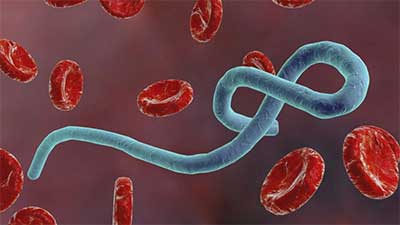Ebola outbreak in Africa's Guinea and Congo
The Africa Centers for Disease Control and Prevention (Africa CDC) recently said Guinea and the Democratic Republic of the Congo (DRC) have reported 30 Ebola virus cases and 15 related deaths so far.
The Africa CDC, the specialised healthcare agency of the 55-member African Union, reported a fatality rate of 50 per cent in the two countries.
New outbreaks of the deadly Ebola virus disease in the two African countries are sending new jitters to Africa as the continent is still grappling with the COVID-19 pandemic.
About Ebola virus disease :
Ebola virus disease (EVD), formerly known as Ebola haemorrhagic fever, is a rare but severe, often fatal illness in humans.
The virus is transmitted to people from wild animals and spreads in the human population through human-to-human transmission. It is thought that fruit bats of the Pteropodidae family are natural Ebola virus hosts. Ebola is introduced into the human population through close contact with the blood, secretions, organs or other bodily fluids of infected animals such as fruit bats, chimpanzees, gorillas, monkeys, forest antelope or porcupines found ill or dead or in the rainforest.
The virus family Filoviridae includes three genera: Cuevavirus, Marburgvirus, and Ebolavirus. Within the genus Ebolavirus, six species have been identified: Zaire, Bundibugyo, Sudan, Taï Forest, Reston and Bombali.
History of this virus :
The Ebola virus causes an acute, serious illness which is often fatal if untreated. EVD first appeared in 1976 in 2 simultaneous outbreaks, one in what is now Nzara, South Sudan, and the other in Yambuku, DRC. The latter occurred in a village near the Ebola River, from which the disease takes its name.
The 2014–2016 outbreak in West Africa was the largest Ebola outbreak since the virus was first discovered in 1976. The outbreak started in Guinea and then moved across land borders to Sierra Leone and Liberia.
Ebola Transmission :
Ebola then spreads through human-to-human transmission via direct contact (through broken skin or mucous membranes) with:
- Blood or body fluids of a person who is sick with or has died from Ebola
- Objects that have been contaminated with body fluids (like blood, feces, vomit) from a person sick with Ebola or the body of a person who died from Ebola
Diagnostic methods For Ebola :
- antibody-capture enzyme-linked immunosorbent assay (ELISA)
- antigen-capture detection tests
- serum neutralization test
- reverse transcriptase polymerase chain reaction (RT-PCR) assay
- electron microscopy
- virus isolation by cell culture.








